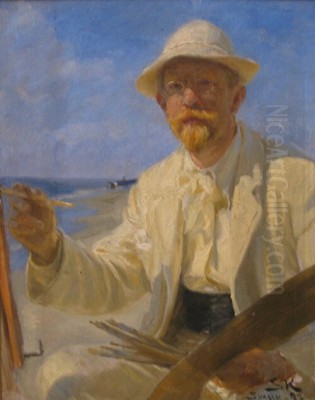
Peder Severin Krøyer stands as one of the most beloved and significant figures in Scandinavian art history. A Danish painter, though born in Norway, he became synonymous with the vibrant artists' colony in Skagen, Denmark, during the late 19th and early 20th centuries. Renowned for his extraordinary ability to capture the effects of light, particularly the unique coastal illumination of Skagen, Krøyer masterfully blended elements of Realism and Impressionism. His works, ranging from intimate portraits and lively social gatherings to evocative landscapes and scenes of local life, continue to enchant viewers with their technical brilliance, atmospheric depth, and celebration of community and nature.
Nordic Roots and Copenhagen Beginnings
Peder Severin Krøyer entered the world on July 23, 1851, in Stavanger, Norway. His early life was marked by instability due to his mother Ellen Cecilie Gjesdal's struggles with mental illness. Consequently, the young Peder was sent to Copenhagen, Denmark, to be raised by his mother's sister, Bertha Cecilie Krøyer, and her husband, the zoologist Henrik Nikolai Krøyer. They formally adopted him, and he grew up bearing their surname, firmly establishing his identity within Danish culture despite his Norwegian birth.
His artistic inclinations surfaced early. Recognizing his talent, his adoptive family supported his pursuit of art. At the tender age of nine, he began private tutoring, and by the age of ten, he was enrolled at the Copenhagen Technical College. His formal academic training commenced in 1864 when he entered the Royal Danish Academy of Fine Arts. He completed his studies there in 1870, benefiting significantly from the tutelage of respected artists like Frederik Vermehren, a painter known for his detailed genre scenes and portraits, who instilled in Krøyer a strong foundation in drawing and traditional techniques.
Formative Travels and Artistic Awakening
Like many ambitious artists of his generation, Krøyer understood the importance of travel for broadening artistic horizons. Supported by patrons, notably the influential tobacco merchant and art collector Heinrich Hirschsprung, who became a lifelong supporter, Krøyer embarked on extensive travels between 1877 and 1881. These journeys proved pivotal in shaping his mature style, exposing him to the latest artistic currents sweeping across Europe.
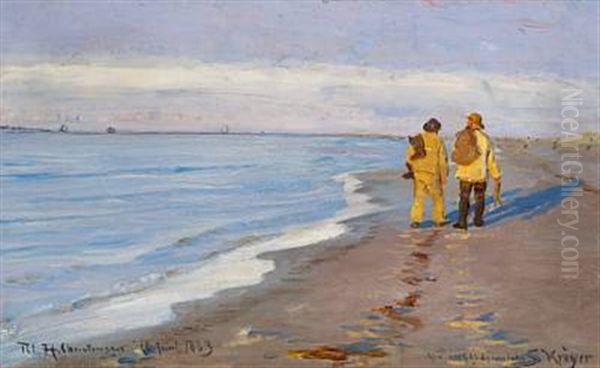
His time spent in Paris was particularly transformative. He briefly studied in the atelier of Léon Bonnat, known for his portraiture and historical paintings, further honing his technical skills. More importantly, Krøyer immersed himself in the Parisian art scene, directly encountering the revolutionary works of the French Impressionists. He absorbed the lessons of artists like Claude Monet, Edgar Degas, Auguste Renoir, and Alfred Sisley, paying close attention to their vibrant palettes, broken brushwork, and dedication to capturing fleeting moments and the effects of natural light (plein air painting). He also admired the Realism of Gustave Courbet and the atmospheric landscapes of the Barbizon School painters such as Jean-Baptiste-Camille Corot.
Beyond France, his travels took him to Spain, where he studied the works of the Old Masters, particularly Diego Velázquez, whose mastery of light and composition left a lasting impression. In Italy, he continued his studies, absorbing the art and culture. These diverse influences began to meld with his academic Danish training, pushing him away from darker, more traditional palettes towards the brighter, more luminous style that would become his hallmark.
The Magnetic Pull of Skagen
In 1882, Krøyer visited Skagen for the first time. This remote fishing village, situated at the northernmost tip of Jutland where the Skagerrak and Kattegat seas meet, was already beginning to attract a community of artists drawn by its dramatic coastal scenery and, crucially, its extraordinary natural light. The unique quality of light, often described as clear and intense due to the reflection from the sea on both sides of the peninsula, captivated Krøyer immediately. He found the landscape, the local fishing community, and the burgeoning artistic camaraderie irresistible.
Krøyer quickly became a central and charismatic figure within the Skagen Painters' colony. While artists like Michael Ancher and his wife Anna Ancher (both significant painters in their own right) were already established figures, Krøyer's arrival injected new energy and a more cosmopolitan, Impressionist-influenced sensibility into the group. Other key members included the Norwegian painter Christian Krohg, the Swedish artist Oscar Björck, and fellow Danes Viggo Johansen, Carl Locher (a marine painter), and Laurits Tuxen (known for his large-scale royal portraits and group scenes).
The Skagen colony was more than just a place to paint; it was a vibrant social hub. Artists gathered, shared meals, debated ideas, and often featured each other in their works. Krøyer, with his outgoing personality and international experience, naturally assumed an informal leadership role, organizing gatherings and fostering a spirit of creative exchange. The summers, in particular, saw Skagen bustling with artistic activity, as painters sought to capture the long daylight hours and the idyllic atmosphere.
Krøyer's Artistic Vision: Style and Subject Matter
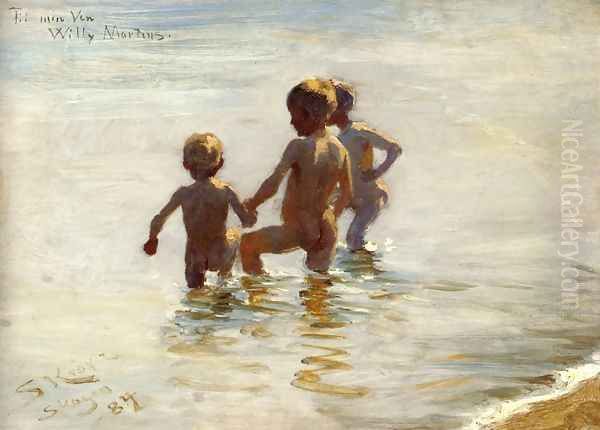
Krøyer's mature style is best characterized as a sophisticated fusion of Realism and Impressionism. He retained the strong drawing skills and attention to accurate representation inherited from his academic training and the Realist movement. However, his palette brightened considerably under the influence of the French Impressionists, and his brushwork became looser and more expressive, particularly in capturing the transient effects of light and atmosphere. He was a master of plein air painting, working outdoors to directly observe and translate the nuances of natural light onto his canvas.
Light was arguably Krøyer's primary subject. He explored it in all its variations: the brilliant sunshine on the Skagen beaches, the warm glow of lamplight in intimate interiors, the dramatic flicker of bonfires, and most famously, the ethereal twilight phenomenon known as the "Blue Hour" (l'heure bleue). This period, occurring shortly after sunset when the sky takes on a deep blue hue, became a signature theme in some of his most evocative works, lending them a melancholic, poetic quality.
His subject matter was diverse but often centered on the life and landscape of Skagen. He painted numerous scenes of the local fishermen – hauling nets, returning with their catch, or relaxing on the shore – depicting their lives with dignity and realism. Portraits were another significant part of his oeuvre; he painted fellow artists, prominent cultural figures, friends, and family members, often capturing their personalities with remarkable insight and warmth. His depictions of the social life of the Skagen artists, featuring elegant dinners, garden parties, and beach strolls, convey a sense of bourgeois leisure and artistic community, bathed in his characteristic luminous light.
Iconic Masterpieces: Capturing Moments in Time
Krøyer's legacy is cemented by several iconic paintings that perfectly encapsulate his style and thematic concerns.
Hip, Hip, Hurrah! Artists' Party at Skagen (1888): This large, vibrant canvas is perhaps the most famous depiction of the Skagen Painters' social life. It captures a celebratory luncheon in the Anchers' garden, with many prominent members of the colony raising their glasses in a toast. Krøyer masterfully handles the complex composition and the dappled sunlight filtering through the leaves, creating a scene brimming with life, camaraderie, and the joy of a specific moment. Figures include Michael Ancher, Anna Ancher, Krøyer himself, Degn Brøndum (Anna's brother and hotel owner), Viggo Johansen, Christian Krohg, and others. The painting took several years to complete, reflecting Krøyer's meticulous approach even within an Impressionistic framework.
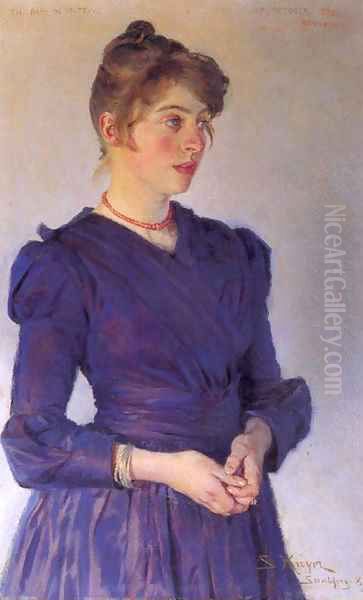
Summer Evening at Skagen Beach – The Artist and his Wife (1899): This painting is one of the most celebrated examples of Krøyer's fascination with the "Blue Hour." It depicts Krøyer and his wife, Marie Krøyer, strolling along the water's edge as twilight descends. The vast expanse of the beach and sea is rendered in subtle, harmonious shades of blue, grey, and violet. The figures are silhouetted against the luminous horizon, creating an atmosphere of profound tranquility and quiet intimacy. The reflections in the wet sand are rendered with exquisite delicacy. A companion piece, Summer Evening on Skagen's Southern Beach (1893), features Marie and Anna Ancher walking together in similar light.
Roses (1893): This charming work depicts Marie Krøyer relaxing in a deckchair in their garden beside their dog, Rap. She is surrounded by a profusion of blooming roses, rendered with vibrant color and textured brushwork. The bright sunlight illuminates the scene, highlighting the textures of the flowers, Marie's white dress, and the foliage. It is a picture of domestic bliss and natural beauty, showcasing Krøyer's skill in capturing both intimate moments and the lushness of nature.
Midsummer Eve Bonfire on Skagen Beach (1906): Painted later in his life, even as his eyesight was failing, this work captures the drama and community spirit of the traditional Midsummer's Eve celebration. A large bonfire blazes against the darkening sky, illuminating the faces of the crowd gathered on the beach. Figures include many familiar faces from the Skagen community, including Anna Ancher and her daughter Helga, and the writer Holger Drachmann. It demonstrates Krøyer's enduring commitment to depicting Skagen life and his remarkable ability to handle complex light effects even under difficult personal circumstances.
Other notable works include his earlier, more Realist depictions like Italian Village Hatters (1880) and various scenes of fishermen, showcasing his versatility and evolution as an artist.
A Complex Personal Life: Art, Love, and Illness
In 1889, Krøyer married Marie Triepcke, a beautiful and talented artist whom he had met in Paris. Marie became his muse, featuring prominently in many of his most famous paintings, including Roses and Summer Evening at Skagen Beach. Their life together, particularly their summers in Skagen where they rented and later owned a house, was deeply intertwined with the artistic community. They had one daughter, Vibeke, born in 1895.
However, their marriage was fraught with difficulties. Krøyer suffered from recurrent episodes of severe mental illness, likely inherited from his mother and possibly exacerbated by syphilis, which he contracted earlier in life. These episodes involved periods of delusion and hospitalization, placing immense strain on Marie and their relationship. Marie, feeling increasingly isolated and constrained, eventually began an affair with the Swedish composer Hugo Alfvén, whom she had met while traveling with Krøyer.
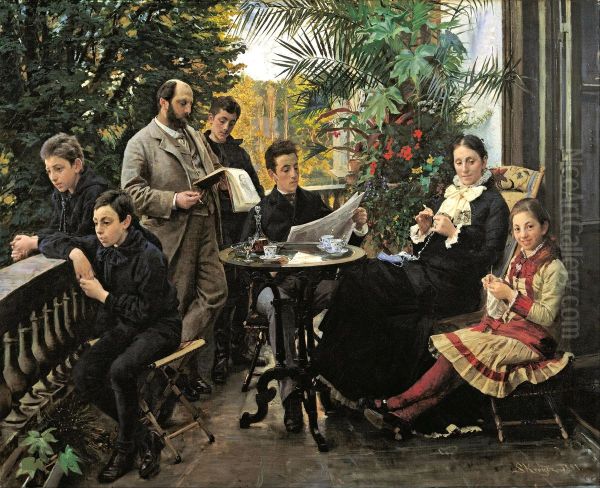
The affair led to a painful separation and eventual divorce in 1905. Marie moved to Sweden with Alfvén, whom she later married, though this relationship also proved tumultuous. Krøyer was deeply hurt by the separation but maintained contact, particularly concerning their daughter Vibeke. Despite the personal turmoil, Krøyer continued to find solace and friendship within the Skagen community, particularly with Michael and Anna Ancher, who remained steadfast supporters throughout his life. The poet and painter Holger Drachmann was another prominent figure in their circle, though Marie would later controversially marry him after Alfvén left her.
Later Years, Declining Health, and Final Works
The final decade of Krøyer's life was increasingly overshadowed by his declining health. The effects of syphilis manifested not only in worsening mental instability but also in gradual vision loss, beginning around 1900. For a painter so attuned to light and visual detail, the prospect and reality of blindness were devastating. Yet, remarkably, Krøyer continued to paint with determination, adapting his techniques as his sight deteriorated.
His late works, such as the Midsummer Eve Bonfire on Skagen Beach, possess a unique power, perhaps intensified by the artist's struggle against his physical limitations. He spent his final years in Skagen, cared for by his daughter Vibeke and supported by his friends. Peder Severin Krøyer died in Skagen on November 21, 1909, at the age of 58, succumbing to the long-term effects of his illness. He was buried in the Skagen cemetery, joining many of his fellow artists.
Legacy and Enduring Influence
Peder Severin Krøyer remains one of the most celebrated artists in Danish history. His works are central to the collections of major Danish museums, including the Statens Museum for Kunst (National Gallery of Denmark) in Copenhagen, the Skagens Museum, and The Hirschsprung Collection in Copenhagen, which holds a significant number of works thanks to the early and continued patronage of Heinrich Hirschsprung.
His influence extends beyond Denmark throughout Scandinavia. As a leading figure of the Skagen Painters, he helped define a significant movement in Nordic art, one that celebrated national identity through the depiction of local landscapes and life, while simultaneously engaging with international trends like Impressionism. His technical brilliance, particularly his handling of light and color, set a high standard and inspired subsequent generations of artists.
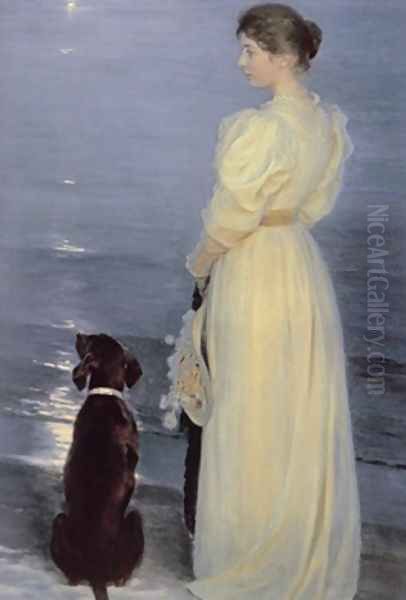
Krøyer received numerous accolades during his lifetime, including medals at the Paris Salons and being made a Knight of the Order of the Dannebrog in 1888. While some later critics might view his work as occasionally leaning towards the picturesque or lacking the radical edge of European modernism, its enduring appeal is undeniable. His paintings continue to resonate with audiences for their beauty, their technical mastery, and their evocative portrayal of a specific time, place, and community. He captured the light of Skagen, but also the light of human connection, leisure, and the simple dignity of work, leaving behind a luminous and cherished legacy.
Conclusion: Denmark's Painter of Light
Peder Severin Krøyer's contribution to art lies in his exceptional ability to synthesize the academic traditions of his training with the revolutionary techniques of French Impressionism, creating a style uniquely his own. As the heart of the Skagen Painters' colony, he not only produced a remarkable body of work but also fostered a vibrant artistic environment. His paintings, celebrated for their luminous quality, technical skill, and evocative subject matter – from the sun-drenched beaches and intimate gatherings to the famous "Blue Hour" scenes – have become iconic images of Danish cultural heritage. Krøyer captured the fleeting beauty of light and life at the turn of the century, securing his place as a master painter whose works continue to inspire and delight viewers worldwide.